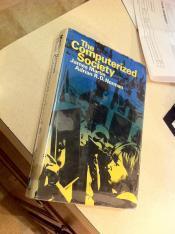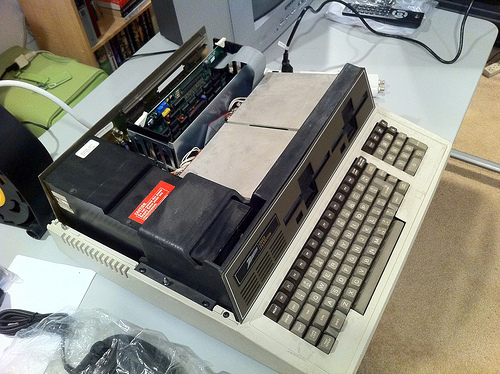Bill Loguidice's Blog, page 140
February 9, 2012
Look inside now active for "My Xbox: Xbox 360, Kinect, and Xbox LIVE"!
[image error]Our latest book, My Xbox: Xbox 360, Kinect, and Xbox LIVE will soon be available at booksellers everywhere in both print and ebook formats. While you can of course pre-order now for delivery in a few weeks, Amazon has enabled their nifty "Click to LOOK INSIDE!" feature, so you can get a taste of the book's content right now. Let me know what you think!
January 30, 2012
Bill's Collection Photos - 02 - Cartels & Cutthroats (1981, SSI), Micro Illustrator (1984, Commodore), and Deathkeep (1996, SSI)
[image error]For this second entry in the ongoing series, I've taken photos of Cartels & Cutthroat$ for the Apple II, Micro Illustrator for the Commodore Plus/4 and C-64, and Deathkeep (AD&D) for the 3DO. Enjoy:
January 28, 2012
Bill's Collection Photos - 01 - Tomy Mini Arcade (Daring Driver), Ultima 2012 Collector's Guide, Gorf (C-64)
[image error]BillWhile casual photos and videos are fine for posting something quickly, sometimes readers want a bit more quality. While I'm not going to put a lot of effort into these per se, i.e., you won't mistake these for studio quality, I will take a bit more care in taking and posting anything in this particular series. For this first entry, I focused on three of the most recent additions to my collection, Tomy's electro-mechanical tabletop, Daring Driver, Commodore's Gorf for the C-64, and the 2012 Ultima Collector's Guide. Enjoy:
January 26, 2012
Some Truly Miscellaneous Collection Photos (PC, MPT-03, C-64, Atari 2600, Mac, Vic-20, Stonekeep)
[image error]Woot! recently had a deal on an 8GB Eye-Fi memory card that I took advantage of for the express purpose of no-brainer automatic photo uploads from my digital camera directly to my Flickr account, which I thought would provide a smoother and higher quality workflow than using my iPhone 4. As such, I set the Eye-Fi up last night and took some very casual photos. While the transfer process really didn't go well (I'll need to experiment a bit more), transferring only two photos correctly and requiring me to manually transfer the rest, the end result was still some photos of recent items in my collection that also happened to be in my staging area, which I decided to share below with some minor commentary so the initial work wouldn't be totally wasted. Enjoy:
January 16, 2012
Working Through My Collection: The Mattel (Radofin) Aquarius (02)
I didn't get much of an opportunity like I hoped for after my first entry to continue working with my Mattel Aquarius collection through this past weekend, but I did get the stuff cleaned up, a bit better organized, and also cataloged, which I'll share in this post. I'm now at least at a good point where I can dive right in, and thanks to suggestions from some of our members, like Rowdy Rob, I also have something of a plan of how I want to share videos and other content that give a sense of working with the computer before I move on to other stuff.
[image error]
The software...
Here's the full list of the items presently in my collection (as always, I'm interested in selling or trading any duplicates):
January 13, 2012
Bill's Podcast 1: How 1970 Saw Our Computerized Society
 The Computerized Society (1970)I was inspired to do my first solo Armchair Arcade Radio audio podcast by a 49 cent book from 1970 that I received in the mail from Amazon today. As you can imagine, this was not just any 49 cent book from 1970, but James Martin's and Adrian R.D. Norman's, The Computerized Society. As mentioned in the podcast, I first learned of this book here. Take a listen to why I think it's so special by playing or downloading the audio file attached to this post, or simply visit iTunes and look up the charmingly misnamed "Armchair Arcade Radio" (it also features videos), or use your favorite podcatcher. Enjoy.
The Computerized Society (1970)I was inspired to do my first solo Armchair Arcade Radio audio podcast by a 49 cent book from 1970 that I received in the mail from Amazon today. As you can imagine, this was not just any 49 cent book from 1970, but James Martin's and Adrian R.D. Norman's, The Computerized Society. As mentioned in the podcast, I first learned of this book here. Take a listen to why I think it's so special by playing or downloading the audio file attached to this post, or simply visit iTunes and look up the charmingly misnamed "Armchair Arcade Radio" (it also features videos), or use your favorite podcatcher. Enjoy.
January 10, 2012
Working Through My Collection: The Mattel (Radofin) Aquarius (01)
In my ongoing quest of late to make more profound use of my collection, I broke out the Mattel (Radofin) Aquarius stuff last night. In the opening to the Aquarius chapter in my as-yet unpublished book, "Videogame and Computer Entertainment Systems: The First 15 Years," I describe the computer as follows:
The Mattel Aquarius is another "quaint" entry in the encyclopedia of home computers. The April 1985 edition of Compute! magazine declared it the computer "with one of the shortest life spans" in history, and indeed, only 20,000 units were ever sold outside of liquidation centers. Production ran for only four months, from June to October 1983. The Aquarius became an unmitigated disaster for Mattel's Mattel Electronics division because the system was sadly obsolete even before it arrived in stores. With Mattel's Intellivision videogame console (discussed elsewhere in this book) hosting two failed computer add-ons of its own, these events did nothing to help steel the company heading into The Great Videogame Crash.
"WHEN MATTEL DEMONSTRATED THIS COMPUTER AT A TRADE SHOW IN 1983, EMPLOYEES HAD TO CONCEAL ONE OF THE KEYS WITH MASKING TAPE. FOR SOME BIZARRE REASON KNOWN ONLY TO MATTEL ENGINEERS, THE AQUARIUS HAD A CONVENIENT KEY THAT INSTANTLY REBOOTED THE COMPUTER AND WIPED OUT ALL YOUR DATA." —FROM BYTE MAGAZINE, SEPTEMBER 1995
So, yeah, not exactly inspiring tech, but the system and its accessories are certainly lookers, even if the hardware inside is lacking.
Here are some views of my Aquarius collection, spread out:
January 8, 2012
Unfortunate Situation with the Heath/Zenith Z-100
Well, I FINALLY got around to setting up my Z-100 and going through all of the stuff, primarily in the interest of getting used to the general operation and then playing the games.
Unfortunately, after plugging it in, it briefly made a noise as if powering up, and then nothing after that. I attempted to open it up and either remove or bypass the power supply (since I have spares of various vintage), but it's really a tight case and screwed in in a configuration that is not particularly easy to tamper with. I gave up. When I mentioned this a little while ago on the SEBHC mailing list group, it was suggested that I check the power supply voltages. If they checked out, that would not be the cause of the issue(s). Naturally, I don't really know how I'd do that. I think one of the things I have to move on my to do list somehow is learning basic electronics if I'm to maintain the type of overall collection I have at present...
I guess I'll either look for an opportunity in the future to re-open it again, preferably with someone more experienced at my side, or just wait for another unit to eventually pop up for a reasonable price on eBay, then sell this one. Of course, I seem to have the worst luck with anything Heathkit (save for the Hero Jr. robot of all things, which works well for me), so I may give up on my whole Heathkit collection at some point down the line. With that said, I have some items that I really like in the Z-100 portion of my collection (particularly since my focus is primarily on games), so I'd really love to make use of them. Here's a very casual inventory I just did, which should be pretty much everything:
January 6, 2012
Bill's Stonekeep Slog 001
Much like my Darklands slog, I have no idea if I'll keep up with this, but I've chosen Stonekeep (which Matt covered in detail here and here) as my "quicker gratification" computer RPG. I did a similar preliminary setup with Stonekep as I did with Darklands, in that I have an original boxed copy of the game, but also have the GoG DOSbox-enhanced version so I can play it directly on my main Windows 7 PC. As I related earlier, Stonekeep was one of the games I owned back in the day in some compilation or another that I was unable to get to run on my PC at the time. That was the way it was back then, where one little incompatibility or not freeing enough main memory for DOS or some such thing would put a serious crimp in your computer game playing plans.
Anyway, my particular boxed copy of Stonekeep came with all the usual stuff, including holographic box cover, CD jewel case with play instructions, nifty hard cover novella, and various warranty cards:
[image error]
What you see under the stack of inserts are tear sheets from a magazine from the day that has both a review and hints, which the previous owner included. Nothing special, of course, but I always appreciate little touches like that.
Quick Thoughts on One Nice Way to Convert SCART (PAL/SECAM) in the US (and G7401/Odyssey3 comments)
[image error]As any hardcore videogame and computer collector knows, there are many intriguing classic systems out there worthy of your time that never made it to your home territory. One of the biggest challenges when importing vintage systems from foreign countries is having the necessary hardware on hand to convert either or both of the power (voltage) and video (television standard) connections.
With vintage Japanese systems in the US, it's fairly trivial to use those systems here. Generally speaking, the video signal is the same - though you may have to tune in a weird channel if you're stuck using an RF connection - and power requirements are similar, generally 100-110v to our 110-120v. While you can usually get away with just plugging a Japanese system direct into a US outlet, a simple power converter is still recommended in some situations. With vintage European systems, it's not nearly as straightforward, since they use a completely different television standard and power requirements usually run 220-240v, so you need to do double conversions. On top of that, plugs for both video and power are often unusual shapes and may require yet another adapter.





